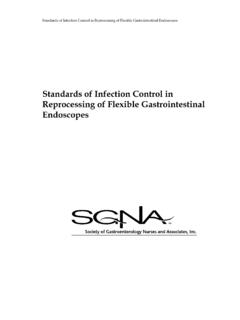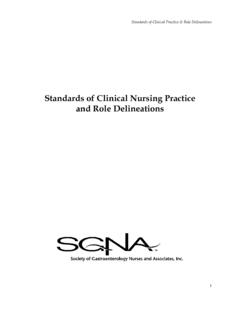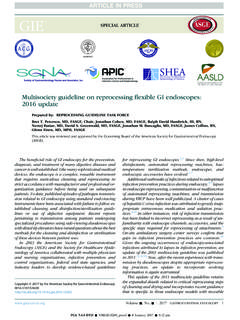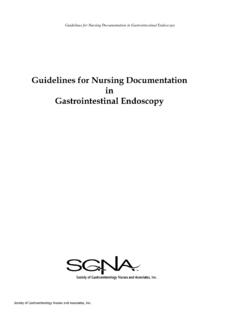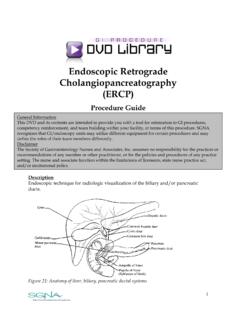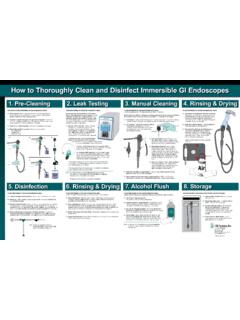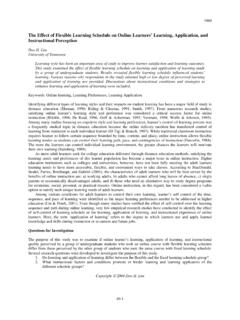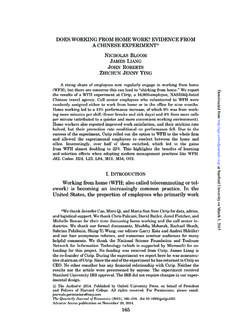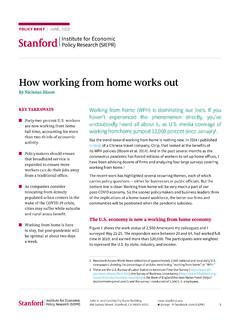Transcription of Guideline for Use of High Level Disinfectants & Sterilants ...
1 Guideline for Use of High Level Disinfectants & Sterilants for Reprocessing Flexible Gastrointestinal Endoscopes Guideline for Use of High Level Disinfectants & Sterilants for Reprocessing Flex. Gastrointestinal Endoscopes Acknowledgements Copyright 2013. Society of Gastroenterology Nurses and Associates, Inc. (SGNA). First published 1998, 2003, 2006, 2007, 2010 & 2013. This document was prepared and written by the SGNA Practice Committee and adopted by the SGNA Board of Directors. It is published as a service to SGNA members. SGNA Practice Committee 2013-14 Michelle R. Juan, MSN, RN, CGRN - Chair Ann Herrin, BSN, RN, CGRN - Co-chair Catherine Concert, DNP, RN, FNP-BC, CGRN Judy Lindsay, MA, BSN, RN, CGRN Midolie Loyola, MSN, RN, CGRN Beja Mlinarich, BSN, RN, CAPA Marilee Schmelzer, PhD, RN Sharon Yorde, BSN, RN, CGRN Kristine Barman, BSN, RN, CGRN Cynthia M. Friis, Med, BSN, RN-BC Reprints are available for purchase from SGNA Headquarters. To order, contact: Department of Membership Services Society of Gastroenterology Nurses and Associates, Inc.
2 330 North Wabash Chicago, IL 60611-4267 Tel: (800) 245-SGNA or (312) 321-5165 Fax: (312) 673-6694 Online: Email: Disclaimer The Society of Gastroenterology Nurses and Associates, Inc. (SGNA) presents this Guideline for use in developing institutional policies, procedures, and/or protocols. Information contained in this Guideline is based on current published data and current practice at the time of publication. The Society of Gastroenterology Nurses and Associates, Inc. assumes no responsibility for the practices or recommendations of any member or other practitioner, or for the policies and practices of any practice setting. Nurses and associates function within the limits of state licensure, state nurse practice act, and/or institutional policy. Guideline for Use of High Level Disinfectants & Sterilants for Reprocessing Flex. Gastrointestinal Endoscopes Table of Contents Preface--------------------------------- ---------------------------------------- ---------------------------------------- ----4 Definition of Terms----------------------------------- ---------------------------------------- --------------------------4 I.
3 General Principles Common to the use of all High- Level Disinfectants --------------------------- -----5 --------- A. Medical Device Classification system---------------------------------- ------------------------------5 ----------B. Product Safety---------------------------------- ---------------------------------------- --------------------6 ----------C. General Characteristics------------------------- ---------------------------------------- -----------------6 ----------D. Biofilm--------------------------------- ---------------------------------------- ------------------------------6 ----------E. Susceptibility of Resistant Organisms------------------------------- ---------------------------------6 ----------F. Determining Minimum Effective Concentration (MEC) ---------------------------------------- 7 ----------G. Personal Protective Equipment ---------------------------------------- -------------------------------8 ----------H. Material Compatibility--------------------------- ---------------------------------------- ---------------8 ----------I.
4 Manual Cleaning ---------------------------------------- ---------------------------------------- ---------8 ----------J. Final Rinse/ Alcohol Purge / Storage--------------------------------- ------------------------------9 II. High- Level Disinfectant and Sterilant Properties and Handling Recommendations-------------9 ---------- A. Glutaraldehyde-------------------------- ---------------------------------------- ------------------------9 ---------- B. Ortho-phthalaldehyde-------------------- ---------------------------------------- --------------------12 ---------- C. Peracetic Acid------------------------------------ ---------------------------------------- ---------------13 ---------- D. Hydrogen Peroxide-------------------------------- ---------------------------------------- ------------15 ---------- E. Peracetic Acid /Hydrogen Peroxide-------------------------------- -------------------------------15 III. Summary--------------------------------- ---------------------------------------- ----------------------------------15 References------------------------------ ---------------------------------------- ---------------------------------------- 16 Recommended Reading--------------------------------- ---------------------------------------- --------------------17 Preface Professional associations and regulatory agencies recognize high- Level disinfection as the standard of care in reprocessing flexible endoscopes (American Society for Gastrointestinal Endoscopy [ASGE] Standards of Practice Committee et al.)
5 , 2008). As of March 2009, the Food and Drug Administration has cleared thirty products as Sterilants and high- Level Disinfectants with general claims for reprocessing reusable medical and dental devices (United States Food & Drug Administration [FDA], 2009). Although several chemicals are cleared by the FDA as both Sterilants and high Level Disinfectants , this document will focus on the high Level disinfectant chemicals. All personnel using chemicals should be educated about biologic and chemical hazards present while performing procedures that use Disinfectants (Petersen et al., 2011). This Guideline provides information about the properties of the main ingredients of these solutions, their safe and effective use, and their compatibility with flexible endoscopes. The current FDA document has listed these products by brand name. It is beyond the scope of this document to review each individual product. A detailed cleaning protocol for endoscopes is found in the Society of Gastroenterology Nurses and Associates, Inc.
6 (SGNA) Standards of Infection Control and Reprocessing of Flexible Gastrointestinal Endoscopes (2012). Refer to endoscope manufacturers guidelines for design features unique to a particular instrument and chemical compatibility. Refer to the FDA for approved high Level Disinfectants / Sterilants for use. Definition of Terms For the purpose of this document, SGNA has adopted the following definitions: Automated endoscope reprocessor (AER) refers to machines designed for the purpose of cleaning and disinfecting endoscopes and accessories. Meticulous manual cleaning must precede the use of AERs (Petersen et al., 2011). Automated endoscope reprocessors limit exposure of personnel to the chemical Disinfectants (American Society for Gastrointestinal Endoscopy Technology Committee et al., 2010; Rutala, Weber, & Healthcare Infection Control Practices Advisory Committee [HICPAC], 2008). Biofilm refers to a matrix of different types of bacteria and extracellular material that can tightly adhere to the interior surfaces of endoscopes (Association for the Advancement of Medical Instrumentation [AAMI], 2010; Miner, Harris, Ebron, & Cao, 2007; Rutala et al.)
7 , 2008). Endoscope refers to a tubular instrument used to examine the interior of the hollow viscera. In this document, endoscope refers only to flexible gastrointestinal endoscopes. Low- Level disinfection refers to a process that can kill most bacteria, some viruses and some fungi. Note that it cannot be relied on to kill resistant organisms such as tubercle bacilli or bacterial spores (United States Food and Drug Administration, 2009; Rutala et al., 2008; Rutala & Weber, 2011). High- Level disinfectant refers to a chemical germicide that has been cleared by the FDA as capable of destroying all viruses, vegetative bacteria, fungi, mycobacterium and some, but not all, bacterial spores (Rutala et al., 2008). High- Level disinfection (HLD) refers to the destruction of all microorganisms with the exception of high levels of bacterial spores (Rutala et al., 2008). Material Safety Data Sheet (MSDS) refers to a descriptive sheet that accompanies a chemical or chemical mixture, and provides the identity of the material; physical hazards, such as flammability; and both acute and chronic health hazards associated with contact with or exposure to the compound.
8 Minimum effective concentration (MEC) refers to the lowest concentration of active ingredient necessary to meet the label claim of a reusable high- Level disinfectant/sterilant (AAMI, 2010; Rutala et al, 2008). Reuse-life refers to a statement by the manufacturer indicating the maximum number of days a reusable high- Level disinfectant/sterilant might be effective (AAMI, 2010). Sterilant refers to a chemical germicide that has been cleared by the FDA as capable of destroying all microorganisms, including all bacterial spores (Rutala et al., 2008; Occupational Safety and Health Administration [OSHA], 2012). Sterile refers to the state of being free from viable microorganisms (AAMI, 2010; Rutala et al., 2008). Sterilization refers to a process resulting in the complete elimination or destruction of all forms of microbial life. The Spaulding Classification identifies sterilization as the standard for medical devices that enter the vascular system or sterile tissue, such as biopsy forceps (Rutala et al.)
9 , 2008). Threshold Limit Value (TLV) refers to airborne concentrations of substances and represents conditions under which it is believed that nearly all workers may be repeatedly exposed day after day without adverse effects, according to the American Conference of Governmental Industrial Hygienists (ACGIH) (AAMI, 2010). Threshold limit value ceiling (TLV-C) refers to the airborne concentration of a substance that should not be exceeded during any part of the working exposure (AAMI, 2010). Threshold limit value time-weighted average (TLV-TWA) refers to the airborne concentration for a normal 8-hour work day and a 40-hour workweek, to which nearly all workers may be exposed day after day without experiencing any adverse health effects (AAMI, 2010). I. General Principles Common to the Use of All High Level Disinfectants and/or Sterilants A. Medical Device Classification System Dr. E. H. Spaulding devised a classification system that divided medical devices into categories based on the risk of infection involved with their use (Petersen et al.
10 , 2011). This classification system is used by the FDA, the Centers for Disease Control and Prevention (CDC), epidemiologists, microbiologists, and professional medical organizations to aid in determining the degree of disinfection or sterilization required for various medical devices. Spaulding defines three categories of medical devices and their associated Level of disinfection or sterilization. 1. Critical: A device that enters normally sterile tissue or the vascular system. These devices must be sterilized. 2. Semi-critical: A device that comes into contact with intact mucous membranes and does not ordinarily penetrate sterile tissue. These devices must receive at least high- Level disinfection. 3. Noncritical: Devices that do not ordinarily touch the patient or touch only intact skin. These devices may be cleaned by low- Level disinfection. B. Product Safety All high Level Disinfectants and Sterilants may have adverse health effects (Rutala & Weber, 2013). It is imperative that healthcare workers who use any high- Level disinfectant and/or sterilant follow Occupational Safety and Health Administration (OSHA) guidelines.
